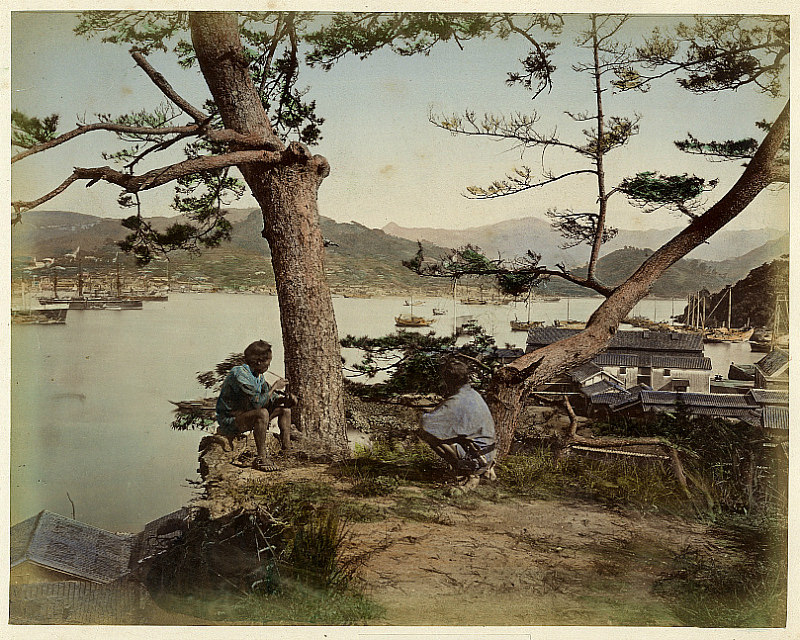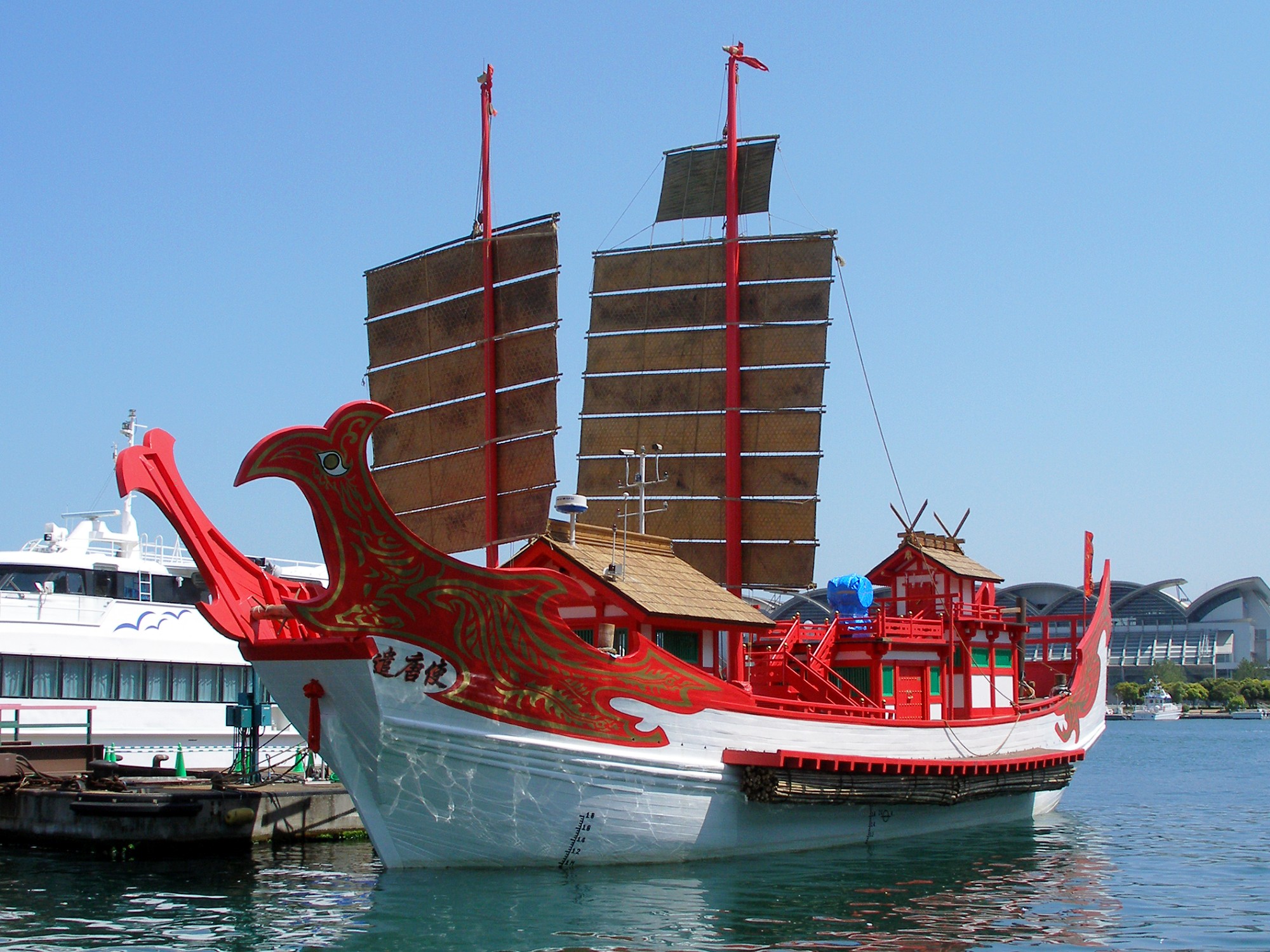|
Shin-Kamigotō
is a town located in Minami-Matsuura District, Nagasaki Prefecture, Japan,encompassing the islands of Nakadori, Wakamatsu and other surrounding islands.It was the headquarters of the Aokata Family, part of the Matsuura clan, who recorded the "Aokata Documents". History The town was established on August 1, 2004 after the merger of the towns of Arikawa, Kamigotō, Narao, Shin-Uonome and Wakamatsu, all from Minami-Matsuura District. Following this merger, it became the only municipality in the Minami-Matsuura District. Location Shin-Kamigotō occupies the two main islands of Nakadōri and Wakamatsu, which are connected by the Oohashi ("Wakamatsu Great Bridge", built 1991) via the small, unpopulated islet of Kaminakajima (上中島), as well as several smaller islands, including the populated islands of Arifuku, Hinoshima, Ryōzegaura, Kashiragashima, and Kirinoko. Wakamatsu Island is connected at its northwestern extremity to Ryōzegaura Island by the Ryōzegaura Br ... [...More Info...] [...Related Items...] OR: [Wikipedia] [Google] [Baidu] |
Kashiragashima Church
Kashiragashima Church is a Catholic church, Catholic church in Shin-Kamigotō, Nagasaki Prefecture, Nagasaki, Japan. The church was first constructed in 1887 as a wooden church but it was renovated and moved to its current location in 1918. It was inscribed as a Unesco world heritage site, World Heritage Site in 2018 along with the western side of Kashigarashima. It forms part of the ''Hidden Christian Sites in the Nagasaki Region'' World Heritage Site. History Kashigaharashima was an uninhabited island until the late Edo period, Edo-period when Kakure Kirishitan, Hidden Christians started settling the island and forming communities. These christians were mostly immigrants from Nakadōri Island and Sotome, Nagasaki, Sotome who were evading persecution. After 1873 when the ban on Christianity was lifted construction of a church soon began. The island's first church was a wooden church that was built at the house of the local christian leader, Domingo Mori. Architect Tetsukawa Yos ... [...More Info...] [...Related Items...] OR: [Wikipedia] [Google] [Baidu] |
List Of Towns In Japan
A town (町; ''chō'' or ''machi'') is a Local government, local administrative unit in Japan. It is a local public body along with Prefectures of Japan, prefecture (''ken'' or other equivalents), Cities of Japan, city (''shi''), and Villages of Japan, village (''mura''). Geographically, a town is contained within a Districts of Japan, district. The same word (町; ''machi'' or ''chō'') is also used in names of smaller regions, usually a part of a Wards of Japan, ward in a city. This is a legacy of when smaller towns were formed on the outskirts of a city, only to eventually merge into it. Towns See also * Municipalities of Japan * List of villages in Japan * List of cities in Japan * Japanese addressing system References External links "Large City System of Japan"; graphic shows towns compared with other Japanese city types at p. 1 [PDF 7 of 40 /nowiki>] {{Asia topic, List of towns in Towns in Japan, * ... [...More Info...] [...Related Items...] OR: [Wikipedia] [Google] [Baidu] |
Gotō Islands
The are Japanese islands in the Sea of Japan. They are part of Nagasaki Prefecture. Geography There are 140 islands, including five main ones: , , , , and . The northernmost island is Ukujima. The group of islands runs approximately from Osezaki Lighthouse, Fukue Island to Tsuwazaki Lighthouse, Nakadōri Island. Its center is near Naru Island at about . To the north is Tsushima Island in the Tsushima Strait and to the east is Kyūshū and the rest of Nagasaki Prefecture. It is about from the port of Nagasaki. The Tsushima Current (a branch of the Kuroshio) passes around the islands. The southern of the two principal islands, Fukue, measures approximately north-to-south by east-to-west; the northern, Nakadōri Island, measures approximately north-to-south by east-to-west at its widest point. Most of Nakadōri Island, however, is quite narrow, measuring less than wide for much of its length. Some dome-shaped hills command the old castle town of Fukue. The isla ... [...More Info...] [...Related Items...] OR: [Wikipedia] [Google] [Baidu] |
Wakamatsu Island
is one of the Gotō Islands in Japan. The island is part of the town of Shin-Kamigotō in Nagasaki Prefecture is a Prefectures of Japan, prefecture of Japan, mainly located on the island of Kyūshū, although it also includes a number of islands off Kyūshū's northwest coast - including Tsushima and Iki. Nagasaki Prefecture has a population of 1,246,4 .... References Islands of Nagasaki Prefecture {{Nagasaki-geo-stub ... [...More Info...] [...Related Items...] OR: [Wikipedia] [Google] [Baidu] |
Nakadōri Island
is an island in the Gotō Islands, Japanese islands in the sea of Japan, off the western coast of Kyūshū. The islands are a part of Nagasaki Prefecture in Japan. History Evidence of human settlement in the on Nakadōri Island trace back to the Jōmon period. In the Heian period, the island were used as port of calls during Japanese missions to Tang China. In August 2004, the towns of Kamigotō, Shin-Uonome, Arikawa, Narao, Wakamatsu merged into a new town named Shin-Kamigotō. In 2017, the island enjoyed a minor boost in tourism after Japanese idol Neru Nagahama is a Japanese television personality, television presenter, and actress. She is a former member of the idol girl groups Keyakizaka46 and Hiragana Keyakizaka46 and current chairperson of the Tokyo Idol Festival. Nagahama joined Keyakizaka46 i ..., who grew up in Narao, released a photobook which features parts of the island. References Islands of Nagasaki Prefecture {{Nagasaki-geo-stub ... [...More Info...] [...Related Items...] OR: [Wikipedia] [Google] [Baidu] |
Nagasaki Prefecture
is a Prefectures of Japan, prefecture of Japan, mainly located on the island of Kyūshū, although it also includes a number of islands off Kyūshū's northwest coast - including Tsushima and Iki. Nagasaki Prefecture has a population of 1,246,481 (1 February 2025) and has a geographic area of 4,130 Square kilometre, km2 (1,594 sq mi). Nagasaki Prefecture borders Saga Prefecture to the northeast. Nagasaki is the capital and largest city of Nagasaki Prefecture, with other major cities including Sasebo, Isahaya, Nagasaki, Isahaya, and Ōmura, Nagasaki, Ōmura. Nagasaki Prefecture is located in western Kyūshū with a territory consisting of many mainland peninsulas centered around Ōmura Bay, as well as islands and archipelagos including Tsushima Island, Tsushima and Iki Island, Iki in the Korea Strait and the Gotō Islands in the East China Sea. Nagasaki Prefecture is known for its century-long Nanban trade, trading history with the Europeans and as the sole place of direct trade ... [...More Info...] [...Related Items...] OR: [Wikipedia] [Google] [Baidu] |
Japan Standard Time
, or , is the standard time zone in Japan, 9 hours ahead of UTC (UTC+09:00). Japan does not observe daylight saving time, though its introduction has been debated on several occasions. During World War II, the time zone was often referred to as Tokyo Standard Time. Japan Standard Time is equivalent to Time in South Korea, Korean Standard Time, Time in North Korea, Pyongyang Time (North Korea), Time in Indonesia, Eastern Indonesia Standard Time, Time in East Timor, East-Timorese Standard Time, Time in Palau, Palau Time, and Yakutsk Time (Russia). History Before the Meiji (era), Meiji era (1868–1912), each local region had its own time zone in which noon was when the sun was exactly at its culmination. As modern transportation methods, such as trains, were adopted, this practice became a source of confusion. For example, there is a difference of about 5 degrees longitude between Tokyo and Osaka and because of this, a train that departed from Tokyo would arrive at Osaka 20 minu ... [...More Info...] [...Related Items...] OR: [Wikipedia] [Google] [Baidu] |
Port Of Call (nautical Term)
A port is a maritime law, maritime facility comprising one or more wharves or loading areas, where ships load and discharge Affreightment, cargo and passengers. Although usually situated on a sea coast or estuary, ports can also be found far inland, such as Port of Hamburg, Hamburg, Port of Manchester, Manchester and Duluth; these access the sea via rivers or canals. Because of their roles as ports of entry for immigrants as well as soldiers in wartime, many port cities have experienced dramatic multi-ethnic and multicultural changes throughout their histories. Ports are extremely important to the global economy; 70% of global merchandise trade by value passes through a port. For this reason, ports are also often densely populated settlements that provide the labor for processing and handling goods and related services for the ports. Today by far the greatest growth in port development is in Asia, the continent with some of the World's busiest ports, world's largest and busiest po ... [...More Info...] [...Related Items...] OR: [Wikipedia] [Google] [Baidu] |
Japanese Missions To Tang China
The were Japanese efforts to learn Chinese culture and civilization from Tang China, in the 7th, 8th and 9th centuries. The nature of those contacts evolved gradually from political and ceremonial change into cultural exchanges, and the process accompanied growing commercial ties which developed over time. From 607 to 839, Japan sent 19 missions to Sui and Tang Empires of China (a mission planned for 894 was cancelled). For each expedition, knowledge and learning were the principal objectives. Priests from Japan studied Chinese Buddhism, officials from Japan studied Chinese government, doctors from Japan studied Chinese medicine, and painters from Japan studied Chinese painting. Approximately one third of those who embarked from Japan did not survive to return home.Hoffman, Michael "Cultures Combined in the Mists of Time: Origins of the China-Japan relationship,"''Asia Pacific Journal: Japan Focus.'' February 3, 2006; reprinting article in ''Japan Times,'' January 29, 2006. S ... [...More Info...] [...Related Items...] OR: [Wikipedia] [Google] [Baidu] |
Heian Period
The is the last division of classical Japanese history, running from 794 to 1185. It followed the Nara period, beginning when the 50th emperor, Emperor Kammu, moved the capital of Japan to Heian-kyō (modern Kyoto). means in Japanese. It is a period in Japanese history when the Chinese influence on Japanese culture, Chinese influences were in decline and the national culture matured. The Heian period is also considered the peak of the Japanese Emperors of Japan, imperial court, noted for its Japanese art, art, especially Japanese poetry, poetry and Japanese literature, literature. Two syllabaries unique to Japan, katakana and hiragana, emerged during this time. This gave rise to Japan's famous vernacular literature, with many of its texts written by court ladies who were not as educated in Chinese as their male counterparts. Although the Imperial House of Japan had power on the surface, the real power was in the hands of the Fujiwara clan, a powerful Kuge, aristocratic family wh ... [...More Info...] [...Related Items...] OR: [Wikipedia] [Google] [Baidu] |
Muromachi Period
The , also known as the , is a division of Japanese history running from approximately 1336 to 1573. The period marks the governance of the Muromachi or Ashikaga shogunate ( or ), which was officially established in 1338 by the first Muromachi ''shōgun'', Ashikaga Takauji, two years after the brief Kenmu Restoration (1333–1336) of imperial rule was brought to a close. The period ended in 1573 when the 15th and last shogun of this line, Ashikaga Yoshiaki, was driven out of the capital in Kyoto by Oda Nobunaga. From a cultural perspective, the period can be divided into the Kitayama and Higashiyama cultures (later 15th – early 16th centuries). The early years from 1336 to 1392 of the Muromachi period are known as the or Northern and Southern Court period. This period is marked by the continued resistance of the supporters of Emperor Go-Daigo, the emperor behind the Kenmu Restoration. The Sengoku period or Warring States period, which begins in 1465, largely overlaps ... [...More Info...] [...Related Items...] OR: [Wikipedia] [Google] [Baidu] |




